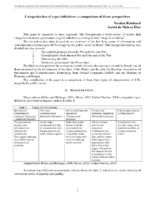Categorization of e-gov initiatives: a comparison of three perspectives

Visualizar/
Data
2005-10Autor
Reinhard, Nicolau
Dias, Isabel de Meiroz
Metadata
Mostrar registro completoResumo
This paper is organized in three segments. The first presents a brief review of models that categorize electronic government (e-gov) initiatives according to their "stage of evolution". Those are normative categorization, which suggest how e-gov evolution should be. The second section aims to provide an overview of the last forty years of information and communication technologies (ICTs) usage by the public sector in Brazil. This background history was divided into four periods: 1) The early beginnings (from the 50s until the mid-60s). 2) Centralization (from the mid-60s until the end of the 70s). 3) Outsourcing (the 80s). 4) Electronic government (the 90s to date). That is a historical categorization, which describes how e-gov evolution in Brazil was. The third section presents the evaluation criteria for two relevant e-gov awards in Brazil, one of them promoted by the Government of the State of São Paulo, and the other by Brazilian Association of Information and Communication Technology State Owned Companies (ABEP) and the Ministry of Planning and Budget. Those criteria suggest a third type of categorization, which describes how the government drives how the e-gov evolution will be. The contribution of the paper is a comparison of those three types of categorization of ICTs usage by the public sector.

